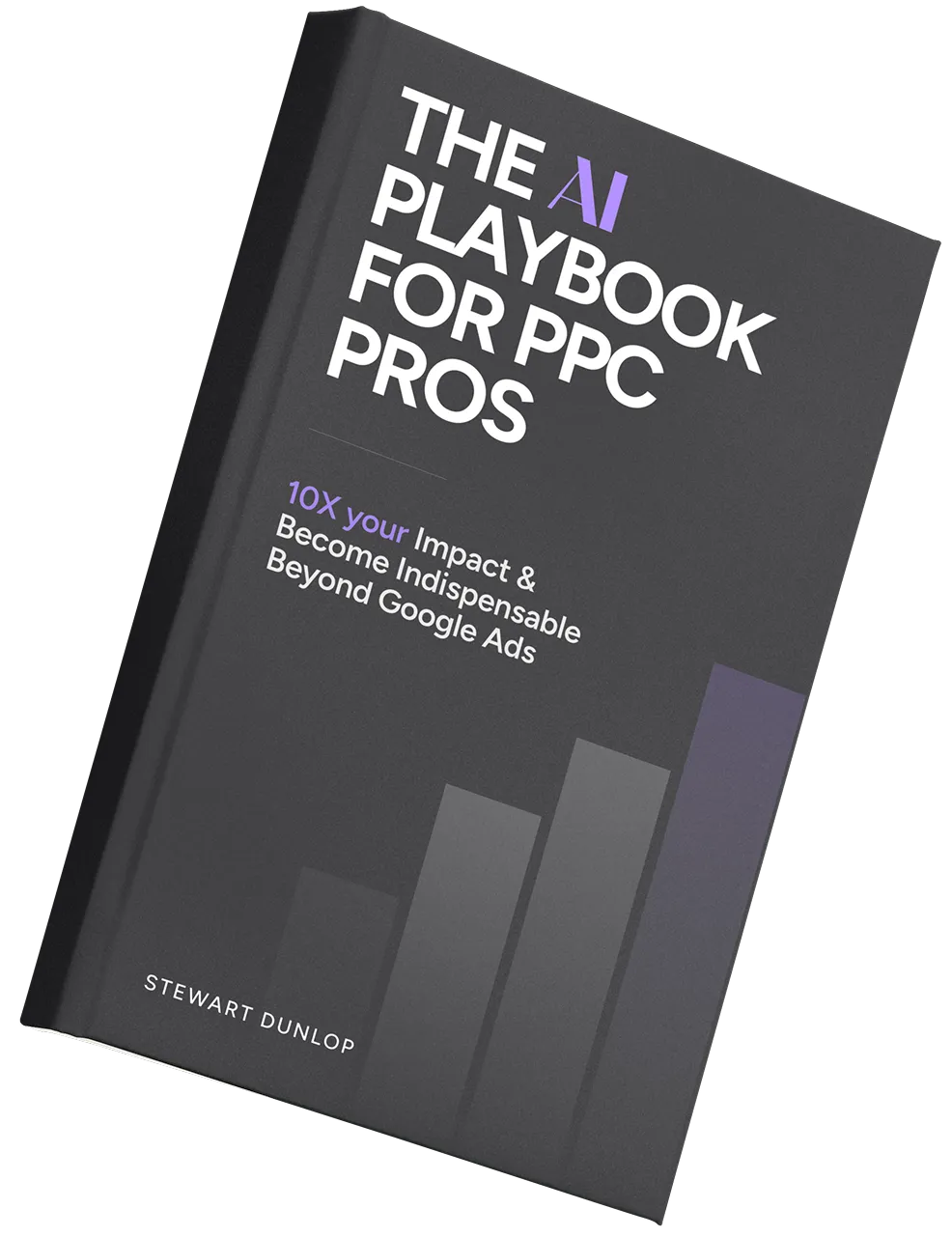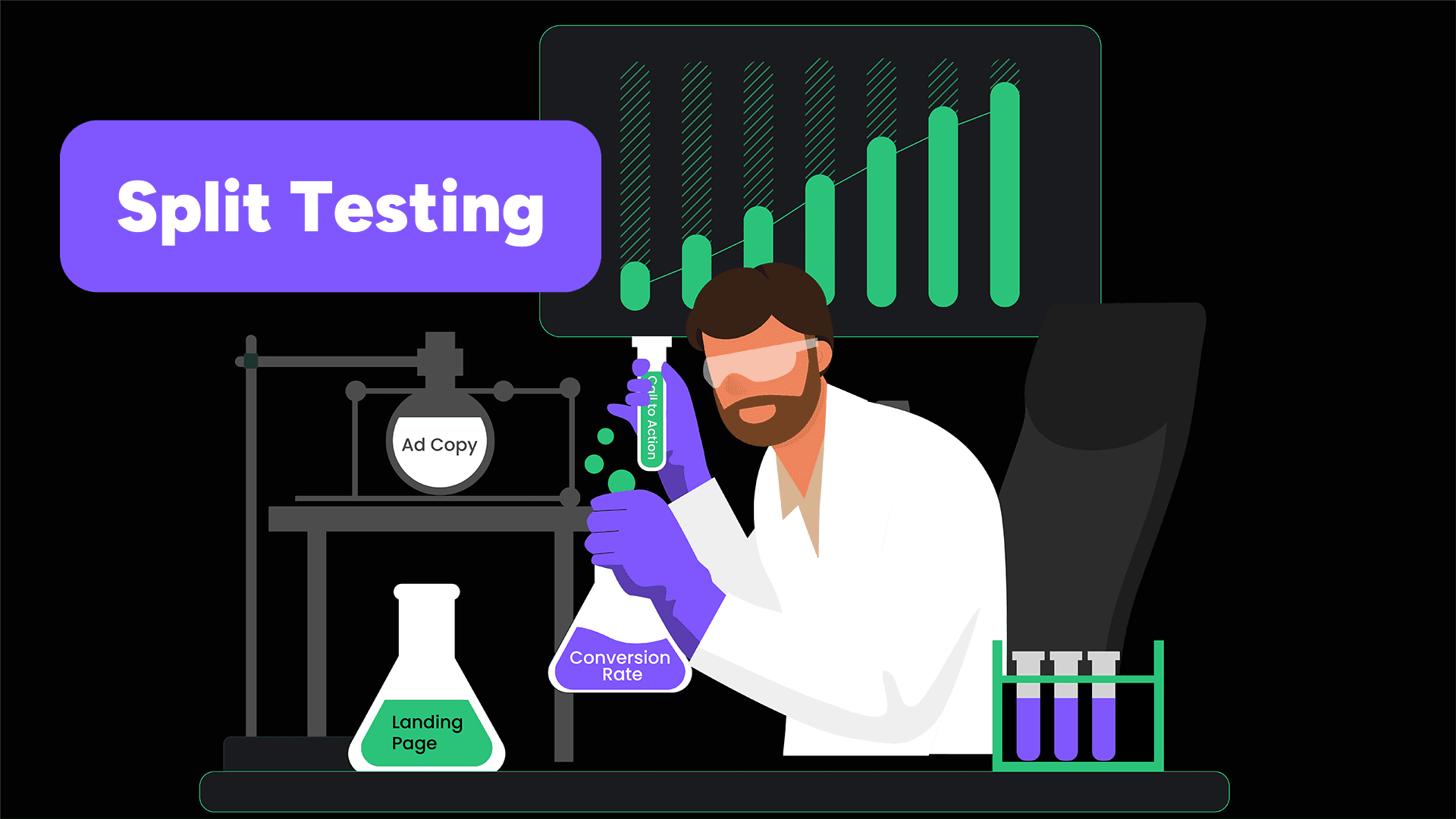
PPC testing is one of the most impactful actions we can take to improve our campaigns over time.
"The top 0.1% of advertisers test 10X more than everyone else" - Alex Hermozi.
This is especially true if you're spending a significant sum of money on your advertising, and want evidence-based re-assure that you're using the optimal PPC strategy.
What is PPC Testing?
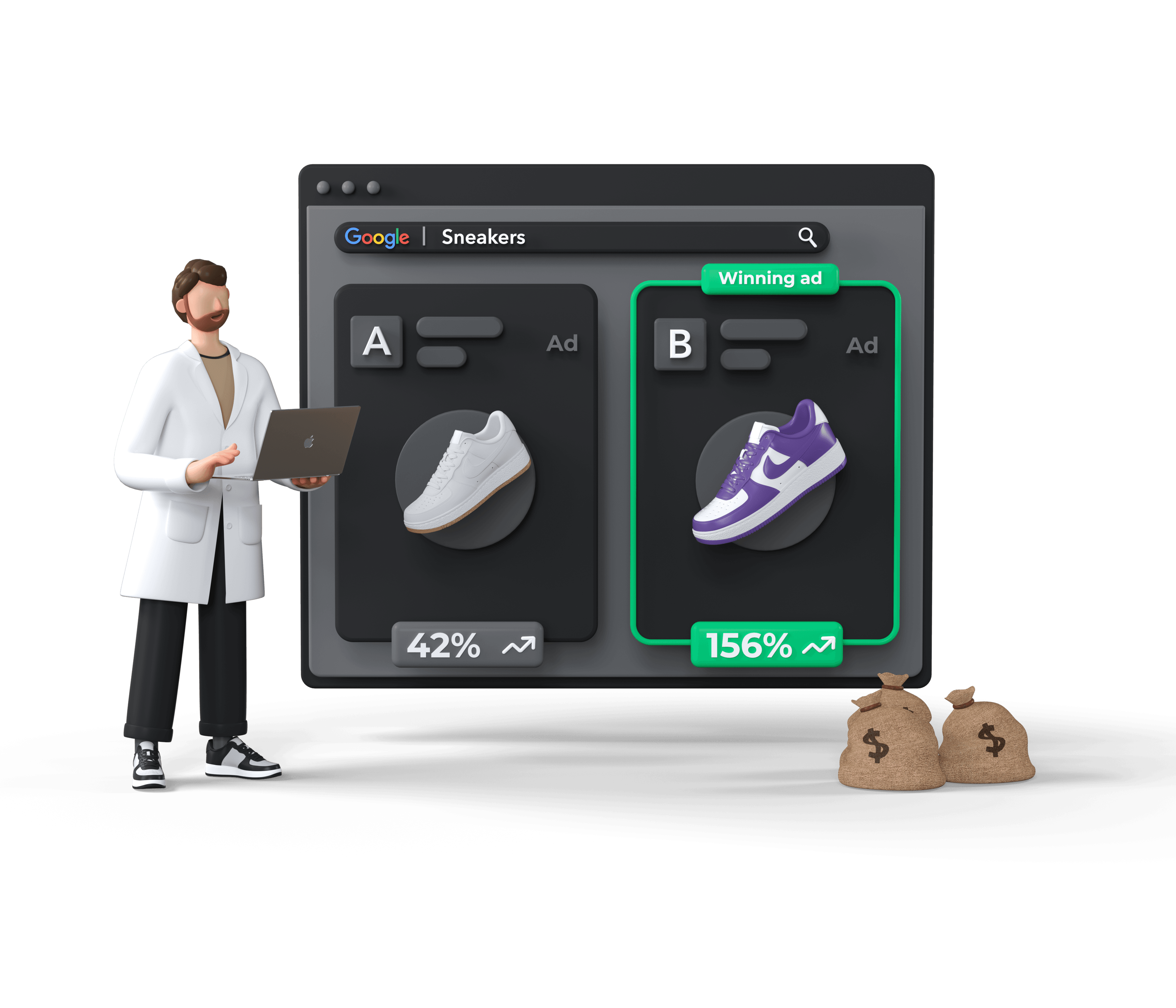
PPC testing refers to the action of running single-variable tests in order to determine the best possible PPC strategy. For example, we might change the offer present in our Google ads headline from "10% off" to "$20 off" and see which headline performs best, given enough time and data.
This process goes by many names, which all mean the same thing:
- Split-testing
- A/B testing
- Bucket testing
- Ad experiments
👉 In this article, we'll dive into the specifics of PPC testing and exactly how you should run effective tests for better results.
💡 Ideas for PPC Tests With AI
There are now Google ads AI agents that can run PPC tests for you in real-time, and come up with the best possible test ideas based on your real Google ads account data.
Here's a few ideas of different PPC tests you can run -
- If a new advert or offer is going to beat an old one.
- If a new bidding strategy is going to improve our results
- If a new landing page design is going to lead to better conversions that an old one.
If you want to achieve this immediately, we strongly recommend using Google ads MCP so that you can connect your data directly to AI chat tools.
Core Principles of Split Testing
Before diving into the step-by-step process of running tests for PPC advertising, it's important to understand the fundamental principles for split testing for PPC campaigns:
- Test One Variable at a Time:Ensure your ads are identical except for one single variable. This could be the call to action (CTA), headline placement, bidding strategy, landing page or any other single variable. This approach helps pinpoint exactly what influences the changes in performance 🎯
- Ensure Sufficient Data: Aim for each ad variant to receive a minimum of 5,000 impressions, but the more the better! If your budget is limited, set a timeline (at least 30 days) and evaluate performance trends over that time period.
- Maintain a Clear Testing Record: Document your tests thoroughly. Use a system to track what tests you've run, their outcomes, and the dates. This prevents you duplicating efforts later on, and that you're clearly progressing towards an optimum strategy.
- Embrace Continuous Testing: Understand that split testing in PPC is an ongoing process. Regularly schedule new tests (every 30 to 60 days) to keep optimizing your ad performance.
"Testing is one of the most rewarding things a PPC marketer can do.
You can sit in meetings all day long and explain exactly why you think one strategy is better than another.
But running tests like a scientist provides conclusive evidence one way or another.
Nobody can argue with a factual outcome.
It doesn't matter if your original hypothesis was right or wrong. What matters is you're improving your PPC campaign and ultimately, making it more profitable."
Remember - It's in Google's best interest to make sure we have the most profitable ad campaigns possible.
Thankfully, that's why they have now made it incredibly easy for it us to set up experiments within the Google Ads platform and run A/B testing for a set length of time.
8 PPC Tests To Implement
PPC testing really doesn't have to be difficult!
We've put together below a list of our 8 best PPC tests that we regularly run for our clients.
1) PPC Ad Copy Test
We're starting with PPC ad copy testing because it's probably the most common PPC test there is.
- Purpose: To determine which ad copy variations result in higher CTR and industry-matching conversion rates.
- Example Test: Set up two different RSAs within Google Experiments to see which one performs better in terms of CTR and conversion.
Here's a few examples of different headline offers we might test within the different ads to help us isolate which PPC ad copy variation performs the best:



2) Broad Match Test
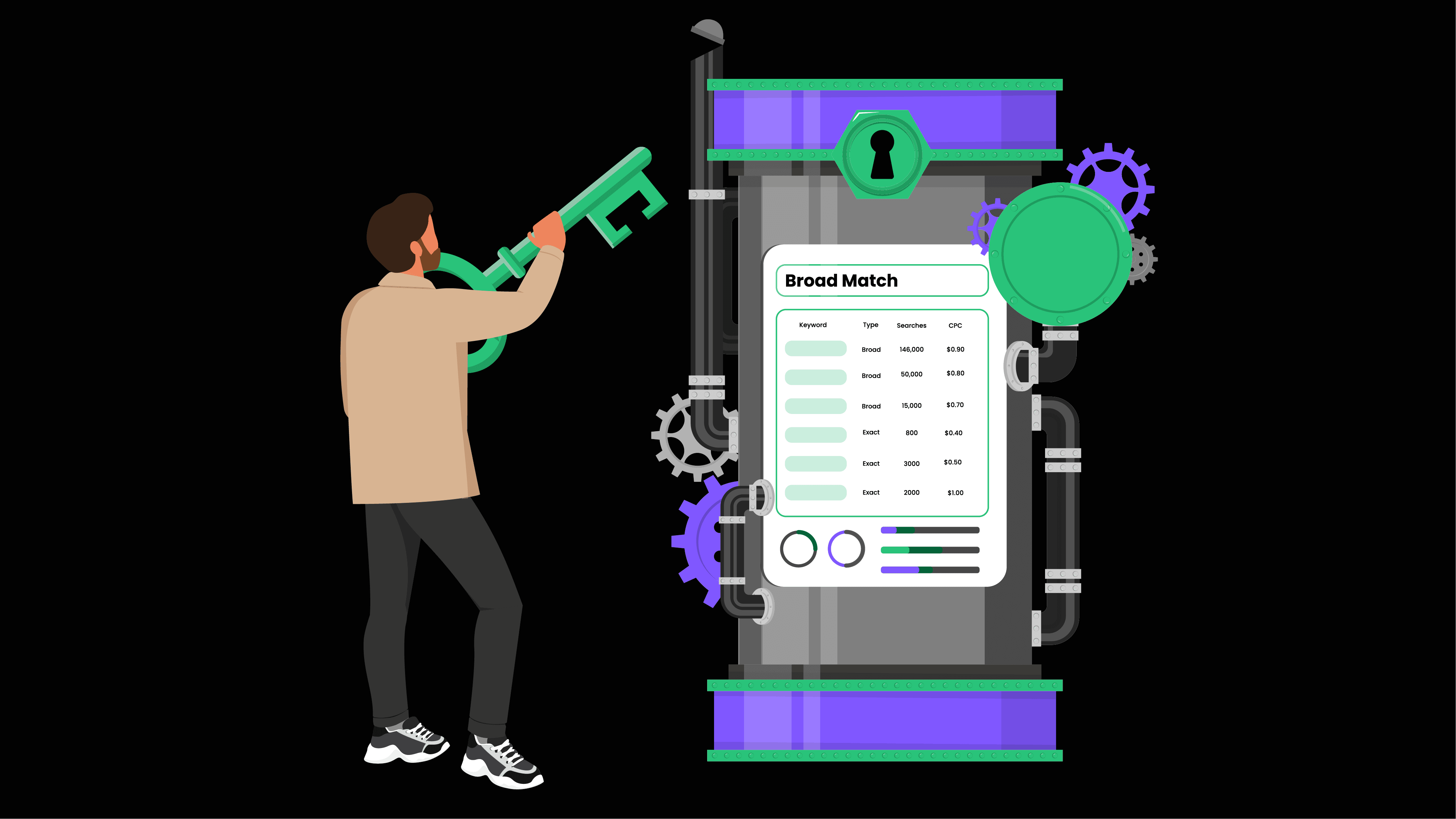
At some stage in your PPC journey you'll want to test broad match keywords.
This usually comes after you've 'exhausted' the capabilities of exact-match keywords and you reach a point where you want to increase your ad spend and go after more potential customers who are not yet aware of your product or service.
- Purpose: To test the effectiveness of broad match keywords against exact match keywords in driving more conversions AND cheaper conversions.
- Example Test: If "Athletic Greens" has an exact match ad for "greens juice" that's performing well but not spending its full budget, introducing a broad match variant for "greens juice" in the same ad group could help them capture additional traffic and conversions.
3) Landing Page Testing
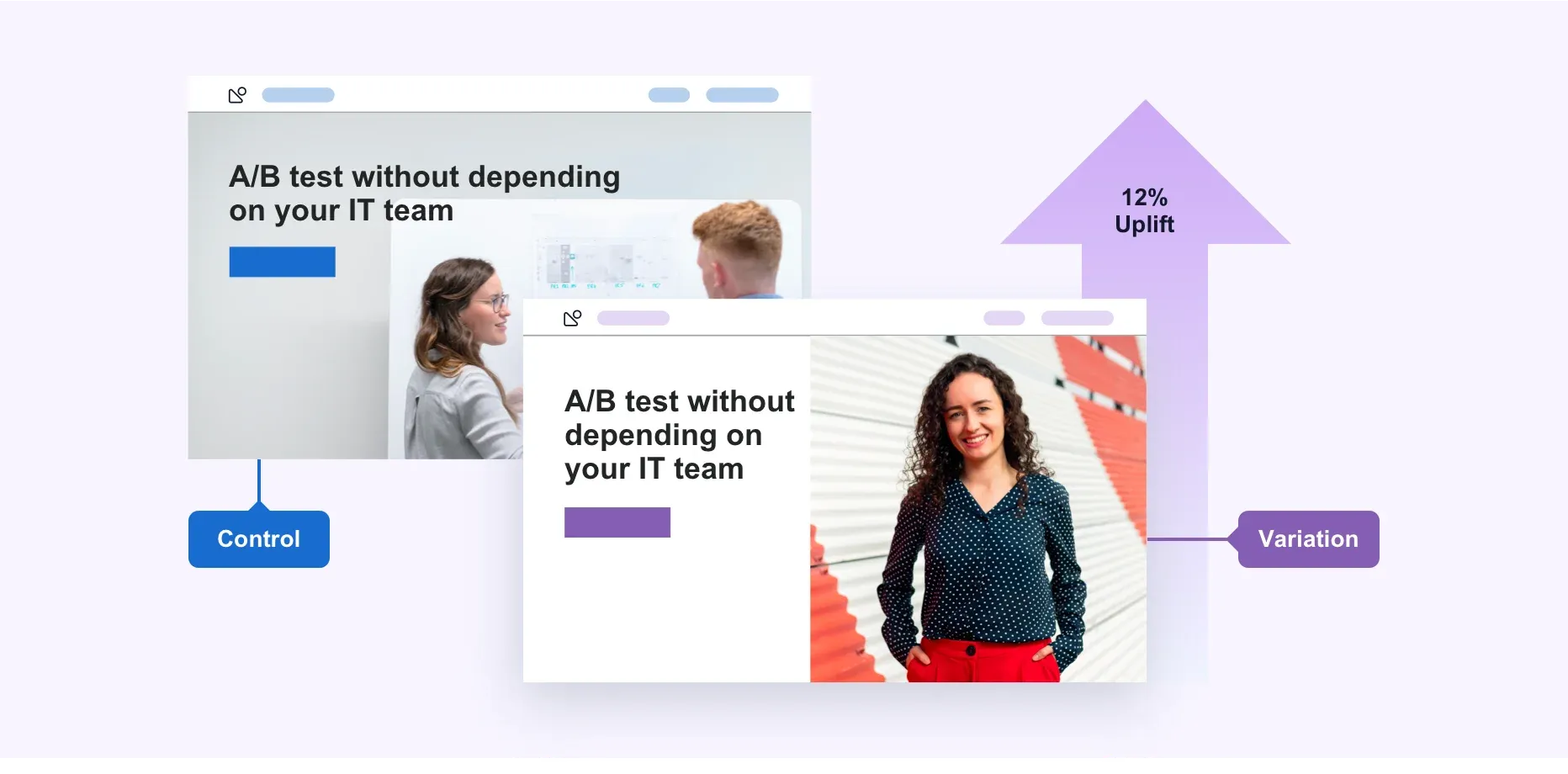
Image courtesy of VWO.
Landing page testing is probably my personal favorite PPC test! This is because it can give you such an unfair advantage against all of your competitors.
There's a few A/B tests we can try here to see which design has a better conversion rate for Google ads.
Let's imagine we're Athletic Greens again 🥬
- Example 1: Split test with one landing page focusing on product benefits and another on customer testimonials.
- Example 2: Split test with one landing page having bright red call to actions, and the other blue.
- Example 3: Split test with one landing page showing a 20% discount offer, and the other a $10 discount offer.
These are all single-variable PPC split tests.
However landing pages are the one exception where we do sometimes advise testing multiple variables within each landing page.
This is normally the case if we have a client who simply has horrible landing pages already that require a complete overhaul.
In this case we're still only changing one variable for our ad experiemnt (the landing page) but of course that landing page will have a completely new design.
Importance of Landing Pages in PPC
We can create the best adverts in the World, and be absolutely World-class at Google Ads.
But if our landing pages suck, then we're always going to have limited PPC performance.
That's why improving your landing page design is so powerful.
We offer a PPC landing page design service to help our client's improve their conversion rates.
4) Keyword Match Tests
The purpose of this test is to evaluate the impact of different keyword match types.
- Broad Match
- Phrase Match
- Exact Match
👉 Example test we could run:
Experiment with "greens juice" splitting into broad, phrase or exact match into different campaigns.
You might be pleasantly to find that different match types deliver a good balance of impression-share, click through rate and conversion rate.
For this test, you should not judge the outcome only on cost per conversion, but also look at other outcomes as well like conversion volume.
This is a particularly good test to run if you're looking to expand your ads budget and want to know how broad match & phrase match keywords might perform.
5) Bid Strategy Testing

Bidding strategy is a test that many PPC marketers will frequently use in order to see improved performance.
It's very rare nowadays that a manual bidding strategy would outperform a smart bidding strategy (bidding strategy automated by Google).
👉 Example:
It may be that on a new PPC account with no data, when transitioning from a manual bidding strategy to an automated strategy like "Maximize Conversions" that you want to create an experiment to test both bidding methods head -o-head over 3-4 weeks, to see which once comes out on top.
For more ideas and information on bidding strategy, check our PPC bidding strategy guide.
6) Ad Extensions Testing
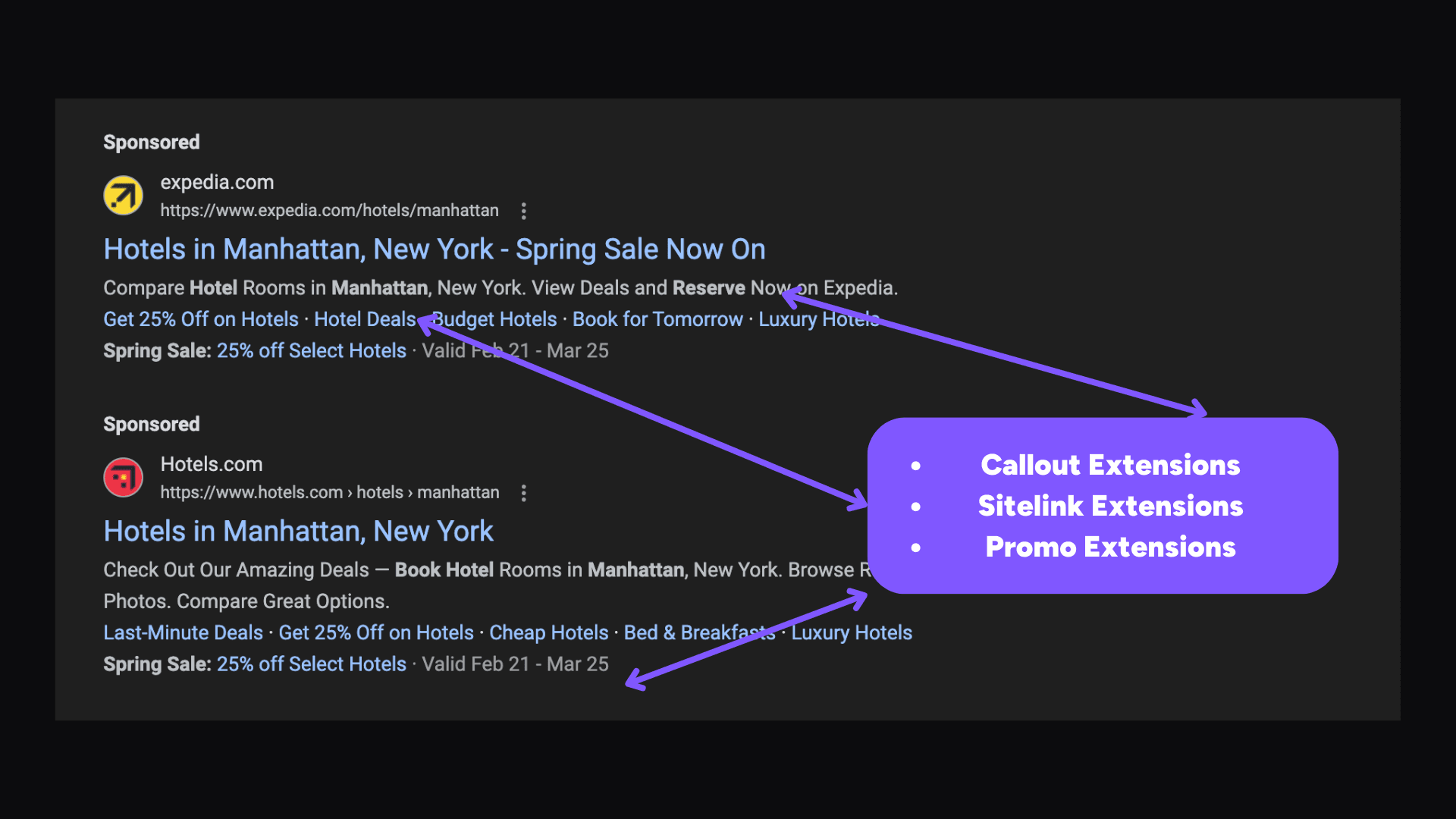
Google's ad extensions (now called assets) are useful pieces of information that are displayed beside your ad headline and descriptions.
Examples of ad extensions assets to test include:
- Sitelink extensions
- Callout extensions
- Location extensions
- Call extensions
- Price extensions
- Promotion extensions
- Seller ratings extensions
- Images extensions - according to Google, these result in a 10% higher click through rate on mobile
- Structured snippets exxtensions
- Lead form extensions
- App extensions
- Affiliate location extensions
So you could for example test your Google ads without image assets and then with image assets to see how your click through rate and conversion rate is impacted.
It's important to note that it's not mandatory to display any extension on your ads, but they generally will help to improve your CTR, because they make the advert more attractive and provide more information.
7) Account Structure Testing

Testing or tweaking our Google ads account structure is something that can yield positive results for PPC performance.
Let's take a look at some examples below.
👉 Example Test 1: Campaign Structure
A/B Testing: Single Theme vs. Multiple Themes per Campaign
Goal: To determine whether concentrating on a single theme (product or service) per campaign yields better results compared to campaigns with multiple themes.
🧠 Example:
- A (Control): Campaign focusing on a broad range of products, like "footwear" which includes sneakers, boots, sandals etc.
- B (Variant): Separate campaigns for each specific product e.g. One for sneakers, another for boots, another for sandals etc.
👉Example Test 2: Ad Group Structure
A/B Test: Keyword Grouping Strategies
Goal: To find out whether tightly themed keyword groups perform better than broader keyword groups within the same campaign.
🧠 Example:
- A (Control): Ad groups with a broad range of related keywords.
- B (Variant): Ad groups with tightly focused keywords related to very specific topics or product features.
8) Performance Max Test
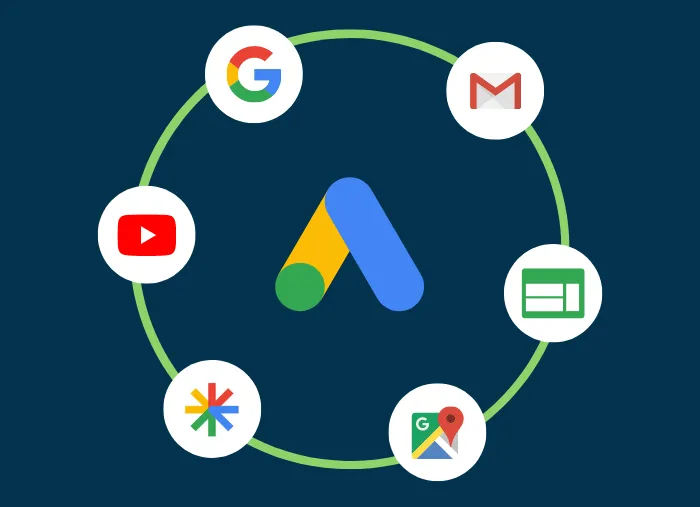
"Performance Max" is Google's newest campaign type that allows advertisers to access the entire Google ads inventory from a single campaign.
That's certainly worth testing for PPC marketers!
It's an incredibly automated type of campaign, and uses Google's AI in every aspect of the campaign, from bidding to budget optimization.
Essentially, Google will distribute your budget in the best way it sees fit across of all its channels, in order to achieve the best goal possible.
So your adverts may show up on Search, YouTube, Display, Maps and Gmail and shopping.
👉 The test here is very simple on purpose - Google wants people to use this new campaign type, and so they've set up 'Performance Max Uplift campaigns' in order to make this very straightforward, to compare performance against your 'standard' campaigns.
We strongly recommend that Ecommerce brands take advantage of Performance Max tests, in order to test the results between Performance Max vs. Standard shopping campaigns.
Companies in the lead generation space (like B2B services) should only test performance max if they are passing lots of conversion data and conversion values back into Google ads, otherwise the quality of leads is likely to be poor.
Google Ads Experiments
We're going to briefly talk about setting up tests via Google Ads, since that's our bread & butter.
Google Search Ads experiments rely on a split-testing framework, allowing advertisers to make data-driven decisions.
It's incredibly easy to set these up within your Google Ads account, simply by pressing the experiments tab.
There are 6 types of experiments currently available:
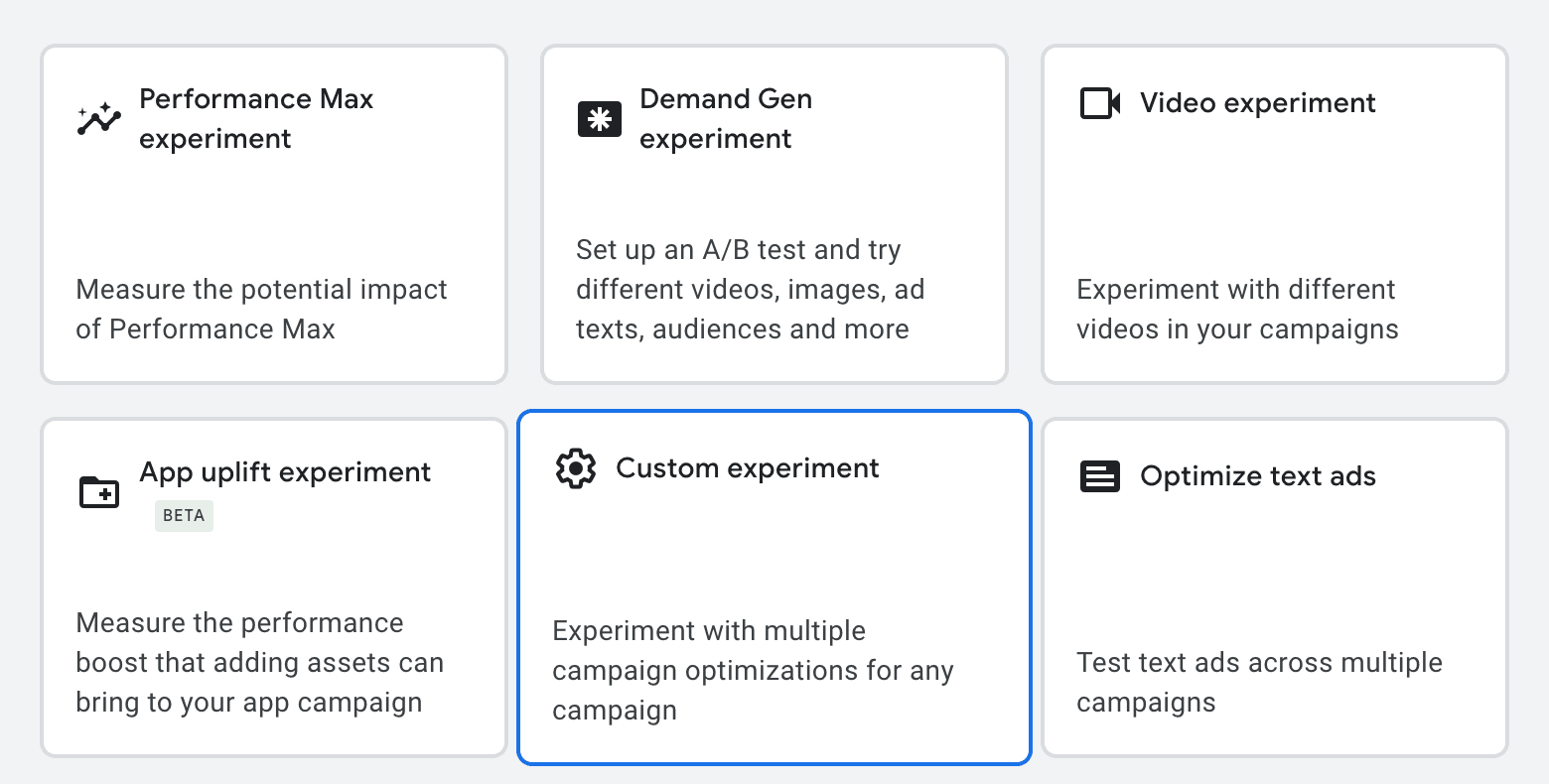
We'll briefly talk through how to set up a "custom experiment" in Google Ads which is the most popular type.
All we're doing here is creating a duplicate version of your original campaign in order to test it against the experiment version, whilst of course making one variable change to the experiment version.
- Click on the experiments tab and create a new experiment.
- Select which campaign you want to experiment on (you must run your experiment on the campaign level)
- Google will then create a new "experiment" version of that campaign for you to change a variable on E.G. change the bidding strategy.
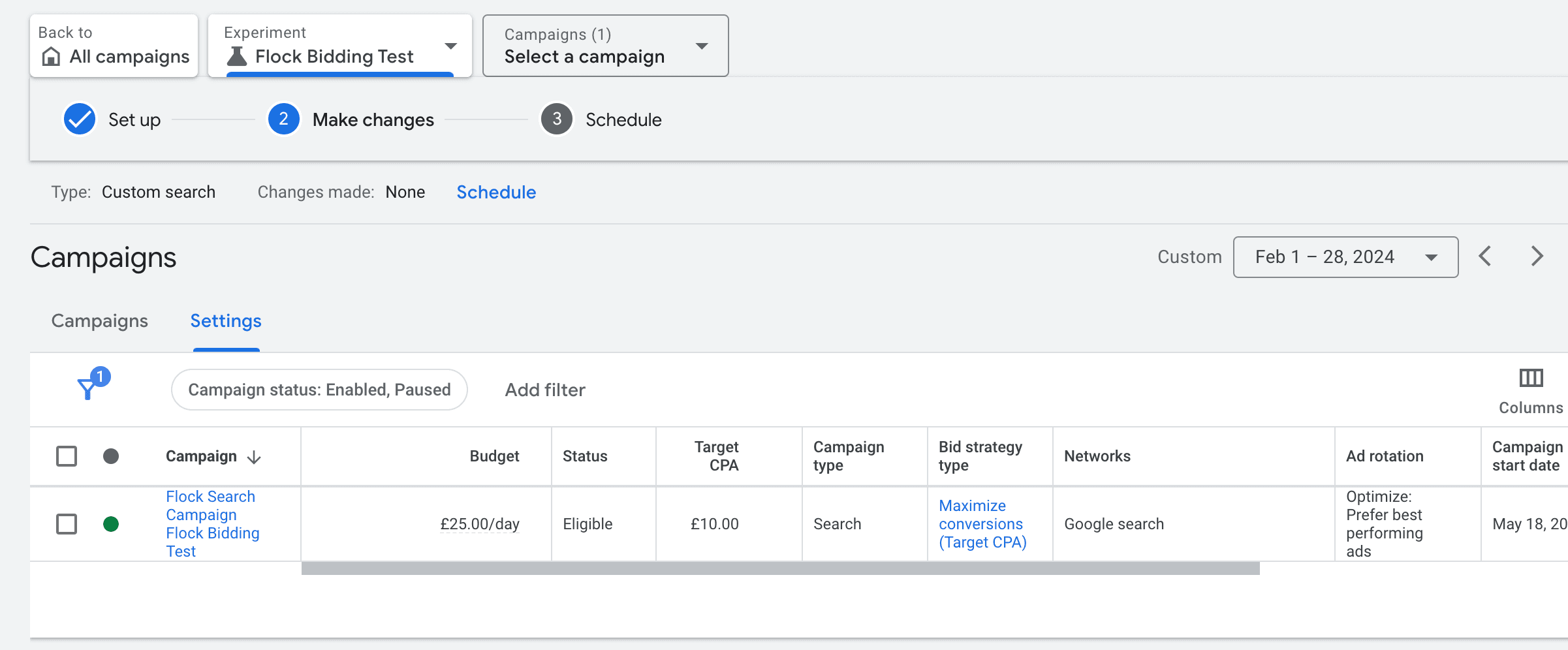
4. Make changes to your experiment, changing 1 variable. For example, your hypothesis may be that switching your bidding strategy to Target ROAS will drive a higher conversion value vs. Target CPA.
5. Once you've made the changes you want to your experiment version, you can move to the next step.
6. Next select up to 2 goals for the experiment.

7. You'll then select how much of your budget to split across the experiment campaign, and your original campaign.
We recommend a 50/50 split.

8. Lastly, you'll schedule a start and end date for the experiment.
👨🔬 And that's all there is to it! You're now a PPC scientist.
After time has elapsed and you've gotten enough data, you can check your results.
See example below.
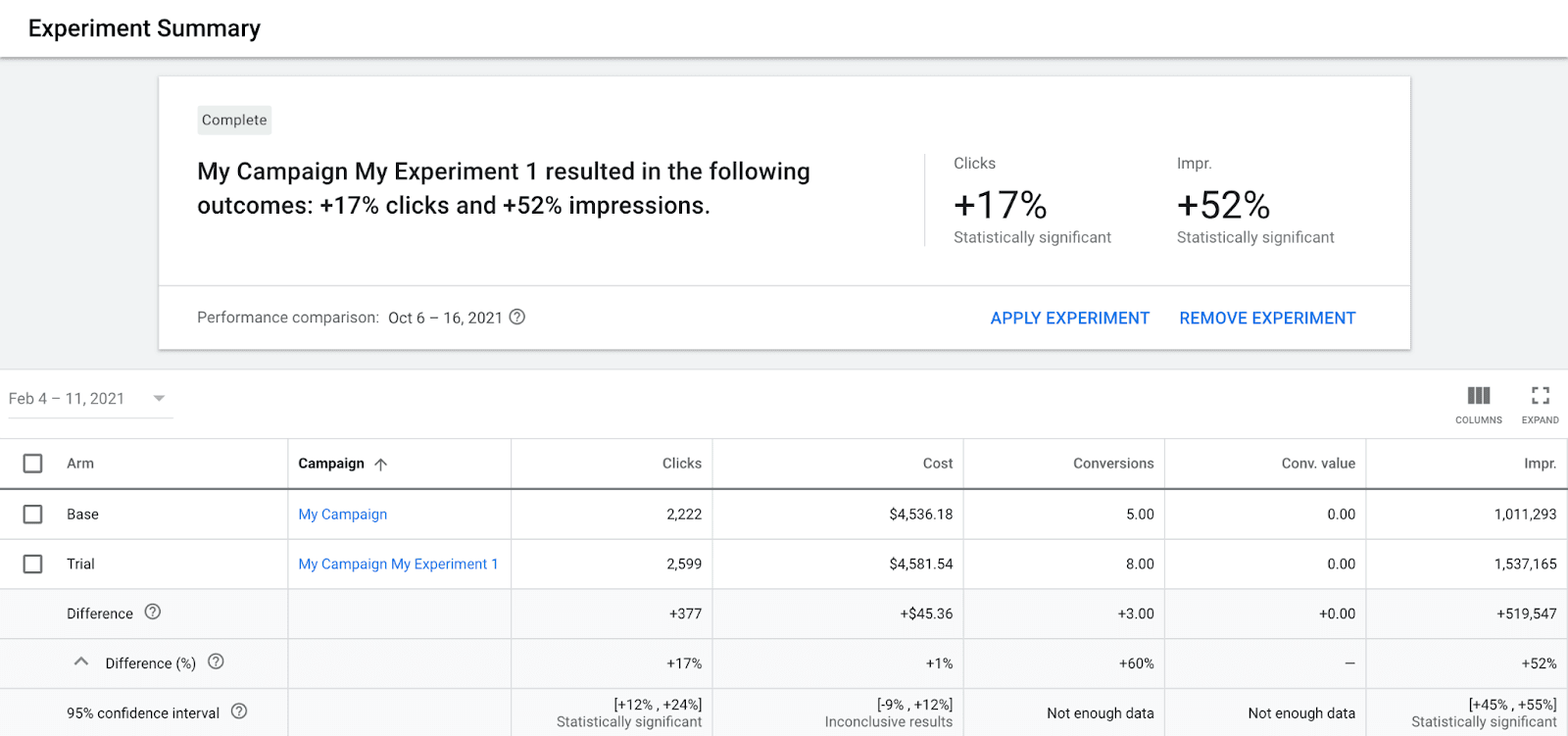
Reacting to Test Results
As mentioned previously, we should only ever be testing one variable at a time.
This allows us to isolate which change caused a better (or worse) outcome.
As soon as you start changing more than one element, it becomes impossible to know what caused the difference in result.
So don't do that, and always stick to one variable!
We should've already picked one or two metrics to gauge the success before our test begins, and this will allow us to easily identify the winning test.
📊 Analyzing Test Results
Once we get the results in for our test, we need to update our tactics based on our learnings.
Within Google Ads, we have the convenient option of updating our original ad campaign based on the changes performed in our test.
That way, if our test campaign performs better, we can very easily replace the original version with the improved test version.
✍️ Keep Test Records
We spoke about this earlier, but it's absolutely vital to keep clear records of all of your PPC tests, so that you have a great base of information for future campaigns, and so that you can clearly track the value of all your PPC marketing efforts.
Best Practices for Tests
It's absolutely vital you allow for enough time and data within your A/B testing for PPC ads.
- Duration: Run experiments for at least a few weeks to gather enough data.
- Singular Variable PPC Testing: Only test one variable at a time to clearly understand its impact.
- Statistical Significance: Make decisions based on statistically significant data to ensure reliability. For eaxmple, if you only have 3 conversions, that's not really enough data to make a reliable decision.
